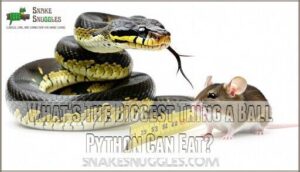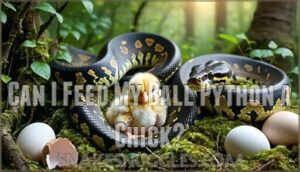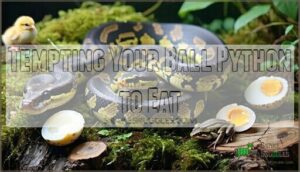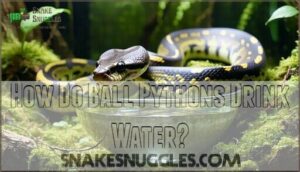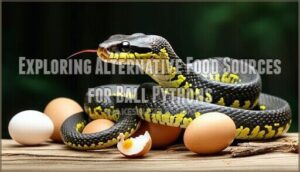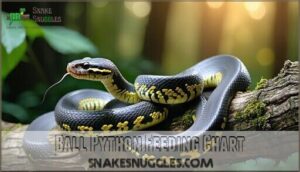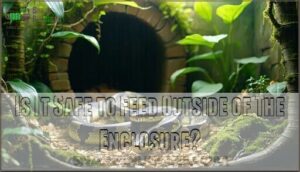This site is supported by our readers. We may earn a commission, at no cost to you, if you purchase through links.
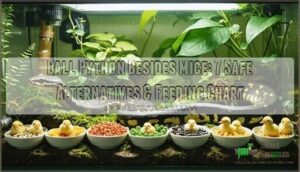
Rats are actually the most popular choice since they’re meatier and provide better nutrition as your snake grows. Young chicks work well for smaller pythons, while quail offers variety for adult snakes.
Always match prey size to your python’s thickest body part – it should be roughly the same width.
Frozen-thawed prey is safer than live feeding and easier to store. Some pythons get picky about their usual meals, so having alternatives prevents feeding strikes.
Proper prey sizing and preparation methods can make all the difference in successful feeding.
Table Of Contents
- Key Takeaways
- What Else Will Ball Pythons Eat?
- What’s The Biggest Thing a Ball Python Can Eat?
- How Do You Feed a Pet Ball Python?
- Can I Feed My Ball Python a Chick?
- Why is My Ball Python Not Eating?
- What Do Ball Pythons Like to Play With?
- How Do Ball Pythons Drink Water?
- Exploring Alternative Food Sources for Ball Pythons
- Ball Python Feeding Chart
- Is It Safe to Feed Outside of The Enclosure?
- Frequently Asked Questions (FAQs)
- Can ball pythons only eat mice?
- What’s the biggest thing a ball python can eat?
- What do ball pythons like to play with?
- Can I feed my ball python a chick?
- Are there any fruits or vegetables that ball pythons can consume?
- How often should I feed my ball python during shedding?
- Is it safe to handle my ball python immediately after feeding?
- Can I feed my ball python a mixture of prey types?
- Can ball pythons eat quail eggs safely?
- How often should adult ball pythons eat?
- Conclusion
Key Takeaways
- You can feed your ball python rats or mice, chicks, quail, or other whole prey instead of mice – rats are actually more nutritious and better for growing snakes.
- Always match prey size to your python’s thickest body part and stick with frozen-thawed options since they’re safer than live feeding and easier to store.
- Feeding variety prevents picky eating and feeding strikes – having alternatives like chicks for smaller pythons or quail for adults keeps your snake eating consistently.
- You’ll need to adjust feeding frequency based on age – hatchlings eat every 5-7 days, juveniles every 7-10 days, and adults only need food every 14-21 days.
What Else Will Ball Pythons Eat?
You don’t have to stick with mice when feeding your ball python.
Your snake can safely eat rats, chicks, quail, hamsters, gerbils, and other whole prey that match their natural diet in the wild.
How to Prepare Frozen Prey
Proper preparation of frozen prey guarantees your ball python gets maximum nutrition without safety risks.
Start by selecting the right thawing methods for your frozen feeders. You’ll want to achieve the perfect internal temperature while maintaining nutritional retention.
Here’s what makes frozen prey preparation stress-free:
- Safe thawing protects your snake from harmful bacteria
- Proper warming techniques encourage natural feeding responses
- Room temperature feeding prevents burns and digestive issues
- Clean handling guarantees maximal nutrition reaches your pet
- Consistent preparation builds trust between you and your python
To help guarantee safe thawing, consider using a reptile thawing container.
Never rush the warmup process or feed cold prey.
Is Feeding Live Okay?
While live feeding seems natural for your ball python diet, it creates serious live prey risks.
Rodents can bite and injure your snake during feeding. The ethical considerations include unnecessary prey suffering and stress for both animals.
Injury potential makes prekilled prey the safer choice. Most reptile experts recommend frozen-thawed alternatives for ball python feeding.
Many owners find frozen meals convenient because they eliminate the need to maintain a rodent habitat. Consult your vet before switching methods.
Do Ball Pythons Need Vitamin Supplements?
Your ball python’s natural diet of whole prey typically meets all nutritional needs without vitamin supplements.
Whole rodents provide complete nutritional balance for healthy reptile nutrition.
However, supplement types like calcium powder can offer supplement benefits during breeding seasons or illness recovery.
Watch for deficiency signs like poor shedding or lethargy.
Always seek veterinary advice before adding supplements to your ball python diet.
Should You Feed Outside of The Enclosure or Inside?
While many keepers debate this topic, feeding your ball python inside its enclosure typically reduces stress and mimics natural hunting behavior.
Moving your snake to a separate container can actually increase anxiety and disrupt digestion.
Here are key considerations for feeding location:
- Enclosure feeding pros: Less handling stress and natural environment
- Separate feeding cons: Increased stress from relocation and handling
- Stress reduction: Familiar surroundings promote better appetite
- Risk of bites: Minimal with proper feeding techniques regardless of location
- Digestion concerns: Stress from moving can cause regurgitation
What’s The Biggest Thing a Ball Python Can Eat?
You can’t feed your ball python prey that’s wider than the thickest part of its body.
The biggest meal should be no more than 1.5 times your snake’s midsection width to prevent serious health problems.
Understanding Prey Size Guidelines
Getting your ball python’s prey size right comes down to three simple rules that’ll keep your snake healthy and happy.
Follow these feeding guidelines to avoid injury and prevent proper nutrition:
- Ideal Prey Weight: Choose rodents that weigh 10-15% of your ball python’s body weight for ideal nutrition.
- Prey Shape Matters: Stick with smooth, cylindrical mice or other prey to prevent digestive issues during swallowing.
- Consistent Size Vital: Never exceed the thickest part of your snake’s midsection when selecting prey.
These overfeeding risks are easily avoided with proper measurements; remember that adult females reach larger sizes than males.
Potential Risks of Overfeeding Large Prey
Beyond proper measurements, overfeeding large prey creates serious health risks for your ball python.
Regurgitation risks increase dramatically when prey exceeds recommended size guidelines. Your snake’s digestive system struggles with oversized rodents, leading to potential organ damage and chronic digestive issues.
Obesity dangers emerge from consistently large meals, causing long-term health complications. Growth problems develop when young pythons receive adult-sized prey too early.
Large prey also increases feeding stress and handling difficulties. Your ball python might strike repeatedly but fail to consume the meal, wasting energy and creating behavioral issues.
Stick to prey that’s 10-15% of your snake’s body weight for ideal health and proper feeding success.
Consistency in Prey Size for Health
Maintaining consistent prey size keeps your ball python’s digestive health on track.
When you stick to proper sizing guidelines, you’re preventing regurgitation and supporting consistent growth throughout your snake’s life.
Your ball python diet should feature prey that’s 10-15% of their body weight – whether that’s mice or other rodent food options.
- Consistent growth: Regular prey sizing supports steady development without digestive stress
- Nutritional balance: Uniform feeding patterns help maintain ideal body condition
Proper prey shape matters too.
Smooth, cylindrical rodents digest easier than irregularly shaped food items, keeping your python comfortable during feeding.
How Do You Feed a Pet Ball Python?
Proper ball python feeding starts with understanding the basics. Always use frozen-thawed rodents rather than live prey for safety. Thaw your prey completely and warm it to body temperature before offering. Use feeding tongs to present food, gently wiggling to trigger hunting instincts.
Wait until hatchlings complete their first shed before attempting to feed them. Feeding frequency depends on your snake’s age – younger pythons need weekly meals while adults eat every 2-3 weeks. Overfeeding can lead to obesity and reduced lifespan.
Choose an appropriate feeding enclosure to reduce stress and create positive associations with mealtime.
- Use frozen-thawed prey warmed to proper temperature
- Feed hatchlings only after their first shed occurs
- Employ feeding tongs to safely present rodents
- Adjust feeding frequency based on python’s age
- Create calm feeding environment to reduce stress and promote a healthy feeding experience.
Can I Feed My Ball Python a Chick?
You can feed your ball python chicks as a safe alternative to mice or rats.
Chicks provide complete nutrition and match what ball pythons eat in the wild where they naturally hunt birds along with rodents.
Exploring Non-Rodent Feeder Options
Five poultry options expand your ball python diet beyond traditional rodents. Bird variety like quail and chicks offer novel proteins that mirror wild feeding patterns. Reptilinks provide convenient processed alternatives, while insect alternatives work for smaller pythons.
These alternative food sources require careful research before introduction. Rodenticides pose significant risks to non-target animals if those rodents are consumed.
| Feeder Options | Benefits |
|---|---|
| Quail | High protein density |
| Chicks | Natural prey variety |
| Reptilinks | Convenient preparation |
| Gerbils | Nutritional balance |
| Guinea pigs | Larger python diet option |
Always consult reptile nutritionists before switching feeder options.
Appropriate Prey Size for Chicks
When selecting chicks for your ball python diet, proper prey size matters most.
Day-old chicks weighing 15-25 grams work well for most pythons.
The chick should match your snake’s widest body section – never exceed this measurement.
Hatchling chick sizes offer excellent nutritional chick value while ensuring chick digestion ease.
- Chick size guidelines: Match snake’s body width for safe feeding
- Python diet balance: Frozen chicks provide complete protein sources
Safety Considerations When Using Chicks as Prey
Chick sourcing matters more than you think. Buy from reputable suppliers to minimize Salmonella risk and guarantee proper nutritional balance.
Size appropriateness prevents choking – match the chick to your snake’s midsection width. Proper thawing eliminates harmful bacteria while maintaining nutrition.
| Safety Factor | Best Practice |
|---|---|
| Source Quality | Reputable feeder suppliers only |
| Thawing Method | Gradual refrigerator thawing |
| Size Matching | Width equals snake’s midsection |
Ball python care demands attention to these feeding safety details, ensuring a proper nutritional balance.
Why is My Ball Python Not Eating?
Your ball python’s feeding strike can happen for several reasons including stress, shedding, or environmental issues.
When your ball python refuses food, don’t panic—it’s often just nature telling them to take a break.
Understanding these causes helps you address the problem and get your snake back to eating regularly, which is crucial for its health and well-being.
Reasons That Ball Pythons Refuse Food
Your ball python’s feeding refusal often stems from natural patterns or environmental issues.
Shedding cycle disruptions, stress factors, and inappropriate prey sizes commonly trigger this behavior. Enclosure temperatures below ideal ranges affect appetite, while illness signs shouldn’t be ignored.
Common reasons for feeding refusal include:
- Shedding cycle stress – Ball pythons stop eating before shedding
- Enclosure conditions – Wrong temperatures or humidity levels
- Prey temperature issues – Frozen prey that’s too cold
- Seasonal breeding behavior – Natural appetite suppression periods
Tempting Your Ball Python to Eat
Appetite stimulants can jumpstart your ball python’s feeding habits when regular prey doesn’t work.
Try scenting prey with mouse or rat scent to trigger feeding preferences. Warming techniques make prey more appealing by mimicking body heat.
Braining prey exposes brain matter, creating stronger odors.
Live feeding stimulates natural hunting instincts, though it requires extra caution for safety.
Seeking Veterinary Advice if Persistent Refusal Occurs
When your ball python’s hunger strikes stretch beyond a few weeks, it’s time to call in the professionals.
When feeding strikes last weeks, your snake needs professional help—don’t wait for serious health issues to develop.
Weight loss signals trouble, and an exotic animal veterinarian can identify hidden health issues through diagnostic testing.
Here’s when to seek specialist referral:
- No eating for 6+ weeks during active season
- Visible weight loss or body condition changes
- Lethargy or unusual behavior patterns
- Temperature and humidity are ideal but refusal continues
- Previous feeding strategies aren’t working
Veterinary advice guarantees your snake’s health stays on track.
What Do Ball Pythons Like to Play With?
You’ll find that ball pythons don’t play like mammals do, but they benefit from environmental enrichment that supports their natural behaviors.
Providing hiding spots, climbing branches, and textured surfaces keeps your snake mentally stimulated and physically healthy, which is essential for their overall well-being and supports their natural behaviors.
Environmental Enrichment for Ball Pythons
Your ball python’s enclosure needs thoughtful planning to create a thriving ball python habitat. Start with a 40-gallon tank that provides adequate space for movement and exploration.
Install hides and security features on both warm and cool sides so your snake feels protected. Adequate python hide options are essential for their well-being.
Add climbing branches to satisfy natural arboreal instincts. Choose burrowing substrates like cypress mulch for comfort and natural behavior.
Maintain proper temperature gradient and humidity control throughout the ball python enclosure. This enrichment setup promotes physical activity and mental stimulation for your pet.
Safe and Enriching Objects for Pet Ball Pythons
Your ball python deserves more than bare walls and empty corners. Creating an engaging environment transforms their space into something special. Smart enrichment choices keep your snake mentally stimulated and physically active.
Here are three categories of safe enrichment objects that’ll transform your ball python’s world:
- Safe hides and caves: Multiple hiding spots throughout the enclosure give your snake security options. Cork bark hollows, ceramic caves, or reptile-safe plastic hides work perfectly.
- Climbing branches and exploration zones: Sturdy, smooth branches encourage natural movement. Your snake will appreciate different levels and textures to investigate.
- Burrowing substrate and water features: Deep substrate allows natural digging behaviors while shallow water dishes provide drinking and soaking opportunities for proper reptile care. To further stimulate them, consider rotating accessories often.
How Do Ball Pythons Drink Water?
Your ball python drinks water by soaking in their water dish and lapping it up with their tongue.
You’ll need to provide a shallow water bowl that’s changed daily to keep your snake properly hydrated.
Encouraging Hydration in Ball Pythons
Beyond play activities, your ball python needs proper hydration support.
Position your water bowl strategically in a quiet enclosure corner.
Misting techniques maintain ideal ball python humidity during shedding hydration periods.
Monitor humidity levels with a hygrometer.
| Hydration Method | Frequency | Benefits |
|---|---|---|
| Water dish size | Daily refill | Primary drinking source |
| Misting frequency | 2-3 times weekly | Maintains ambient moisture |
| Humidity monitoring | Check daily | Prevents dehydration |
| Shedding support | Increase during shed | Aids skin removal |
Providing Accessible Water Sources
The right water setup makes all the difference for your ball python’s health. Place a shallow, sturdy dish on the cooler side of the enclosure where your snake can easily access it.
Water dish size should match your python’s body width – too small won’t meet hydration needs, while oversized bowls create humidity problems. Monitor hydration signs like clear eyes and smooth skin.
Replace water every few days to maintain water quality and prevent bacterial growth. Room temperature water encourages natural drinking behavior better than cold water.
A suitable dish can be found at various online retailers. Misting techniques can boost humidity, but limit misting frequency to avoid oversaturation.
Your snake care routine should include checking the water bowl daily for debris. Proper water source placement combined with consistent humidity levels keeps your ball python properly hydrated and healthy.
Exploring Alternative Food Sources for Ball Pythons
You should always research new food options carefully before offering them to your ball python.
Talk to a reptile expert or veterinarian before you try feeding anything different from your snake’s regular diet.
Importance of Research and Caution
Smart decisions start with solid research when exploring new prey options for your ball python. Verify Sources through scientific studies and established reptile nutrition guides before making changes.
Different prey types affect your snake’s health in ways you mightn’t expect. Expert Consultation becomes essential when considering prey variety beyond standard mice.
Veterinarians and experienced keepers understand how various prey selection choices impact digestion and nutrition. They’ll guide you through safe experiments.
Observe Changes in your python’s behavior, weight, and overall health when trying new foods. Some snakes react differently to unfamiliar prey size or texture.
Safe Handling practices protect both you and your snake during feeding experiments. Preventative Care means researching thoroughly before experimenting with your pet’s diet.
Reminder to Consult Experts Before Experimenting
Why rush into uncharted feeding territory when expert consultation can save your ball python’s life? Before experimenting with new prey options, reach out to reptile veterinarians, experienced breeders, or seasoned hobbyists.
These professionals understand the delicate balance of ball python nutrition and can guide you through safe experimentation. Expert consultation isn’t just smart—it’s essential. Veterinary guidance helps you navigate:
- Correct prey species and appropriate sizes for your snake’s age
- Proper preparation and handling techniques for alternative feeding options
- Potential health risks and ethical considerations you might overlook
Research importance can’t be overstated regarding your pet’s wellbeing. Don’t let curiosity put your snake at risk. Professional advice guarantees you’re making informed decisions about feeding shifts. Your ball python depends on you to prioritize safety over convenience, and consulting experts demonstrates responsible ownership that leads to decades of healthy companionship.
Ball Python Feeding Chart
Getting your ball python’s feeding schedule right can make all the difference in their health and happiness.
You’ll need to know exactly how often to feed based on your snake’s age and what size prey works best for their current body size, which is crucial for their overall happiness.
Feeding Frequency Guidelines
Getting your ball python’s feeding schedule right makes all the difference between a healthy snake and constant worry.
Age-based frequency changes as your python grows, so adjusting frequency becomes second nature. Watch for hunger signs like increased activity or tongue flicking.
Your feeding routine should match these guidelines:
| Age Range | Feeding Intervals | Notes |
|---|---|---|
| Hatchlings (0-6 months) | Every 5-7 days | Rapid growth phase |
| Juveniles (6 months-2 years) | Every 7-10 days | Steady development |
| Adults (2+ years) | Every 14-21 days | Maintenance feeding |
This feeding advice prevents overfeeding while ensuring proper nutrition, which is crucial for the snake’s development and overall well-being, leading to a long and happy life.
Prey Size Recommendations
Getting your ball python’s prey size right isn’t rocket science, but it’s vital for their health. The ideal prey weight should be 10-15% of your snake’s body weight.
You’ll need to adjust prey size as they grow, avoiding oversized prey that can cause serious problems. Prey shape matters too – smooth, cylindrical items digest easier.
Consistent sizing keeps your ball python healthy and growing properly.
| Age Stage | Prey Type | Weight Range |
|---|---|---|
| Hatchling | Pinky mice/rats | 1-3 grams |
| Juvenile | Fuzzy mice/rat pups | 5-25 grams |
| Subadult | Hopper mice/weaner rats | 25-50 grams |
| Adult | Adult mice/rats | 50+ grams |
Transitioning Between Feeding Frequencies With Age
Adjusting your ball python’s feeding schedule as they mature prevents overfeeding and supports healthy digestion rates.
Young snakes need frequent meals to fuel rapid growth, while adults require longer intervals between feedings.
Watch for hunger cues like active searching behavior to fine-tune your approach.
This gradual shift guarantees your snake thrives at every life stage.
| Life Stage | Feeding Frequency | Prey Size |
|---|---|---|
| Juvenile feeding | Every 5-7 days | Pinky to fuzzy mice |
| Subadult intervals | Every 10-14 days | Hopper to adult mice |
| Adult frequency | Every 14-21 days | Adult mice to small rats |
Is It Safe to Feed Outside of The Enclosure?
Many owners wonder if they should move their ball python to a separate container for feeding time.
Moving your snake to feed it outside its enclosure can actually cause stress and increase the risk of regurgitation, so it’s safer to feed them in their home habitat, which reduces the risk of regurgitation.
Minimizing Stress During Feeding
Feeding your ball python outside its home cage requires careful attention to stress reduction. Create a calm feeding environment away from household noise and bright lights.
Your separate feeding enclosure should maintain proper enclosure temperature to support healthy digestion. Handle your snake gently when moving it, supporting its body weight completely.
Present prey naturally by wiggling it slightly to trigger your ball python’s natural feeding behavior. Recognize stress signs like defensive posturing or excessive movement during the process.
Avoid handling after feeding for at least 48 hours to prevent regurgitation. When making gradual diet changes, maintain this same stress-free approach.
Minimizing stress during feeding promotes better digestion and keeps your snake comfortable throughout the entire process.
Ensuring Safety for Both The Snake and The Feeder
Beyond stress reduction, protecting everyone involved requires smart precautions. Your ball python’s feeding safety depends on proper handling techniques and equipment preparation.
Follow these bite prevention steps:
- Use feeding tongs to maintain distance between your hands and the ball python
- Verify frozen mice reach room temperature before offering as prey
- Never handle your snake immediately after feeding sessions
- Keep bite-ready supplies nearby during every feeding routine
Feeder welfare matters equally – injury risks decrease when you prioritize safety protocols and ethical sourcing practices.
Frequently Asked Questions (FAQs)
Can ball pythons only eat mice?
Contrary to popular belief, your ball python doesn’t need just mice to thrive.
You can offer rats, chicks, quail, hamsters, and gerbils for variety, providing complete nutrition while mimicking their diverse wild diet.
What’s the biggest thing a ball python can eat?
Your ball python can eat prey up to 5 times its widest body section. For large adults, that’s typically adult rats, small rabbits, or chickens. Bigger isn’t always better though.
What do ball pythons like to play with?
Don’t expect bells and whistles – ball pythons aren’t playful pets.
They don’t need toys or entertainment like mammals do.
You’ll find they prefer hiding spots, climbing branches, and secure spaces that mimic their natural habitat instead of interactive playthings.
Can I feed my ball python a chick?
Yes, you can feed your ball python chicks.
They’re nutritious alternatives to mice and rats.
Choose appropriately sized chicks – no wider than your snake’s thickest body section for safe digestion.
Are there any fruits or vegetables that ball pythons can consume?
Ball pythons are obligate carnivores who shouldn’t eat fruits or vegetables as their primary diet.
However, small amounts of fruits and vegetables can occasionally be offered as treats, though they’re nutritionally unnecessary for your snake’s health.
How often should I feed my ball python during shedding?
During shedding periods, your snake’s appetite naturally decreases, so don’t force feeding. Skip their regular meal if they’re actively shedding, then resume normal feeding schedule once the process completes successfully.
Is it safe to handle my ball python immediately after feeding?
No, don’t handle your ball python right after feeding.
Wait at least 48-72 hours to avoid causing regurgitation, which stresses your snake and wastes valuable nutrition.
Let digestion happen undisturbed first.
Can I feed my ball python a mixture of prey types?
Picture your snake’s dinner plate filled with variety like a buffet spread.
You can absolutely mix prey types – rats, chicks, quail, and gerbils create nutritional diversity.
Rotate different options to keep feeding interesting and nutritionally balanced.
Can ball pythons eat quail eggs safely?
You shouldn’t feed your ball python quail eggs.
These snakes need whole prey items like rodents or birds for complete nutrition.
Eggs lack essential nutrients and don’t provide the balanced diet your python requires.
How often should adult ball pythons eat?
Adult ball pythons don’t need frequent meals like you might think. You can feed them every 10 to 21 days, depending on their size and the prey size you’re offering.
Conclusion
Switching from the same old mouse routine to diverse prey options transforms your ball python’s feeding experience completely.
Feeding your ball python besides mice opens up a world of nutritional benefits and prevents stubborn feeding strikes.
Rats provide superior nutrition for growing snakes, while chicks and quail add variety to their diet.
Remember to match prey size to your snake’s thickest body part and always use frozen-thawed options.
Your python will thrive with proper alternatives.
- https://www.quora.com/Are-there-any-treats-that-I-can-feed-my-ball-python-on-occasion
- https://ball-pythons.net/forums/showthread.php?94029-Alternetive-food-for-ballpython
- https://www.zenhabitats.com/blogs/reptile-care-sheets-resources/ball-python-complete-food-guide?srsltid=AfmBOopQgAjDzuEiL6Zuw_iAL_hor4FyyjnFIsvQKkxFXBlWHFE8CzDU
- https://www.reddit.com/r/ballpython/comments/zmnqpu/is_there_any_substitutions_for_feeding_aside_from/
- https://www.uwabamireptiles.com/blog/alternative-prey-items

